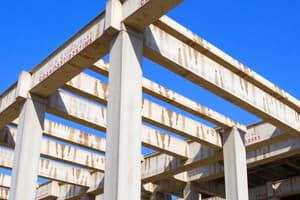Podcast
Questions and Answers
Which of the following is NOT a primary reason for using steel as a reinforcing material in concrete structures?
Which of the following is NOT a primary reason for using steel as a reinforcing material in concrete structures?
- Steel develops a good bond with concrete, allowing for effective stress transfer between the two materials.
- Steel is significantly cheaper than concrete, reducing overall construction costs. (correct)
- Steel has a high tensile strength, complementing concrete's compressive strength.
- Steel and concrete have a similar coefficient of thermal expansion, minimizing stress due to temperature changes.
In the theory of simple bending, plane sections are assumed to remain plane after bending. What is a direct consequence of this assumption?
In the theory of simple bending, plane sections are assumed to remain plane after bending. What is a direct consequence of this assumption?
- The stress distribution across the section is curvilinear.
- The neutral axis always lies at the centroid of the section.
- The stress distribution across the section is linear. (correct)
- The strain distribution is non-linear.
What distinguishes an over-reinforced concrete section from an under-reinforced section?
What distinguishes an over-reinforced concrete section from an under-reinforced section?
- An over-reinforced section fails by steel yielding before concrete crushing, while an under-reinforced section fails by concrete crushing before steel yielding.
- An over-reinforced section fails suddenly due to concrete crushing before the steel yields, while an under-reinforced section provides a warning before failure due to steel yielding. (correct)
- An over-reinforced section is always more economical than an under-reinforced section.
- An over-reinforced section has a lower steel ratio than an under-reinforced section.
Which of the following factors does NOT directly influence the shear strength of concrete?
Which of the following factors does NOT directly influence the shear strength of concrete?
Why is minimum shear reinforcement provided in reinforced concrete beams, even when the calculated shear stress is less than the concrete's shear capacity?
Why is minimum shear reinforcement provided in reinforced concrete beams, even when the calculated shear stress is less than the concrete's shear capacity?
What is a key difference in the approach to safety between the working stress method (WSM) and the limit state method (LSM) of reinforced concrete design?
What is a key difference in the approach to safety between the working stress method (WSM) and the limit state method (LSM) of reinforced concrete design?
Under what condition is it most appropriate to design a reinforced concrete beam as a 'doubly reinforced' beam?
Under what condition is it most appropriate to design a reinforced concrete beam as a 'doubly reinforced' beam?
In a one-way slab, why is the main reinforcement provided along the shorter span?
In a one-way slab, why is the main reinforcement provided along the shorter span?
What fundamentally distinguishes an axially loaded column from an eccentrically loaded column?
What fundamentally distinguishes an axially loaded column from an eccentrically loaded column?
What is the primary function of lateral ties in a reinforced concrete column?
What is the primary function of lateral ties in a reinforced concrete column?
Flashcards
Purpose of Reinforcement
Purpose of Reinforcement
Steel provides tensile strength, complementing concrete's compressive strength, enhancing overall structural integrity and load-bearing capacity.
Simple Bending Theory
Simple Bending Theory
Idealized model simplifying complex stress distributions, assuming perfect bond between steel and concrete, plane sections remain plane, and linear elastic behavior.
Under vs. Over-Reinforced
Under vs. Over-Reinforced
Under-reinforced: Steel yields first, gradual failure. Over-reinforced: Concrete crushes first, brittle failure. Moment resistance depends on material properties and section geometry.
Shear Strength Factors
Shear Strength Factors
Signup and view all the flashcards
Working Stress vs. Limit State
Working Stress vs. Limit State
Signup and view all the flashcards
Doubly Reinforced Beam
Doubly Reinforced Beam
Signup and view all the flashcards
One-Way Slab
One-Way Slab
Signup and view all the flashcards
Prestressed Concrete
Prestressed Concrete
Signup and view all the flashcards
Column Load Types
Column Load Types
Signup and view all the flashcards
Nominal Diameter of Bar
Nominal Diameter of Bar
Signup and view all the flashcards
Study Notes
- The exam is for Reinforced Cement Concrete Structure (RCC Structures), code number 2107.
- The maximum possible score is 50 points, and the minimum passing score is 17 points.
- The exam duration is 2 hours and 30 minutes.
- Students are advised to verify the accuracy of numerical data in both the English and Hindi versions of the question paper, resolving discrepancies by referring to the English version.
- The use of pagers and mobile phones is prohibited during the examination.
- Use of BIS: 456-2000 is permitted in the examination.
Purpose of Reinforcement
- Reinforcement is used in concrete to improve its tensile strength.
- Steel is used as a reinforcing material because of its high tensile strength and compatibility with concrete.
Simple Bending Theory Assumptions
- The theory of simple bending relies on assumptions about material behavior and cross-sectional geometry to simplify the analysis of bending in structural members.
Under-Reinforced vs. Over-Reinforced Section
- An under-reinforced concrete section fails due to the steel reaching its yield strength before the concrete reaches its ultimate compressive strain.
- An over-reinforced concrete section fails due to the concrete reaching its ultimate compressive strain before the steel yields.
- The moment of resistance differs in under-reinforced and over-reinforced sections based on the failing material's stress and strain characteristics.
Factors Affecting Shear Strength of Concrete
- Factors affecting the shear strength of concrete include the concrete grade, percentage of tensile reinforcement, shear reinforcement, axial force, and the presence of shear cracks.
- Minimum shear reinforcement is provided to prevent sudden failure due to diagonal tension cracks and to provide ductility of the member.
Working Stress Method vs. Limit State Method
- The working stress method uses a factor of safety to ensure stresses remain within allowable limits under service loads.
- The limit state method considers various limit states (e.g., collapse, serviceability) and uses partial safety factors for loads and materials to ensure an acceptable level of safety and serviceability.
Doubly Reinforced Beam
- A doubly reinforced beam includes steel reinforcement in both the tension and compression zones to increase the moment capacity and control deflection, especially in situations where the dimensions of the beam are restricted.
- Doubly reinforced beams are used when the bending moment exceeds the capacity of a Singly reinforced beam.
One Way Slabs
- One-way slabs are structural elements supported on two sides, causing them to bend primarily in one direction.
- Main steel is provided along the shorter span in a one-way slab because the bending moment and deflection are greater along the shorter span, requiring more reinforcement to resist the induced stresses.
One Way RCC Slab Design Steps
- One-way RCC slab design involves determining the slab thickness, calculating the design loads, computing bending moments and shear forces, selecting appropriate reinforcement, and verifying serviceability requirements.
Prestressed Concrete
- Prestressed concrete is a type of concrete in which internal compressive stresses are introduced to counteract tensile stresses resulting from applied loads.
- Advantages of prestressed concrete include higher span-to-depth ratios, reduced cracking, and improved durability.
- Disadvantages of prestressed concrete include higher initial costs and the need for specialized equipment and skilled labor.
Column Definitions
- A column is a vertical structural member primarily designed to resist axial compressive loads.
- Axially loaded columns experience compressive force applied along the longitudinal axis, resulting in uniform stress distribution.
- Eccentrically loaded columns experience compressive force applied off-center from the longitudinal axis, resulting in a non-uniform stress distribution and bending moments.
Types of Reinforcement in a Column
- Longitudinal reinforcement resists compressive loads and bending moments, preventing buckling of the concrete.
- Lateral ties prevent buckling of longitudinal bars and provide confinement to the concrete core improving the ductility and strength of the column.
Neutral Axis Depth and Beam Section Type
- To determine the depth of the neutral axis of a beam section 250 mm x 400 mm (effective), reinforced with three bars of 20 mm diameter, M20 grade of concrete and Fe 415 steel are used.
- Determining how the neutral axis depth relates to the depth of the section the type of beam section can be found: Under-reinforced, Over-reinforced, or Balanced.
Terms to Define
- Nominal diameter of bar.
- Seismic loads.
- Grade of concrete.
- Modular ratio.
- Neutral axis.
- Balanced section.
- Development length.
- Effective length of a column.
Studying That Suits You
Use AI to generate personalized quizzes and flashcards to suit your learning preferences.




